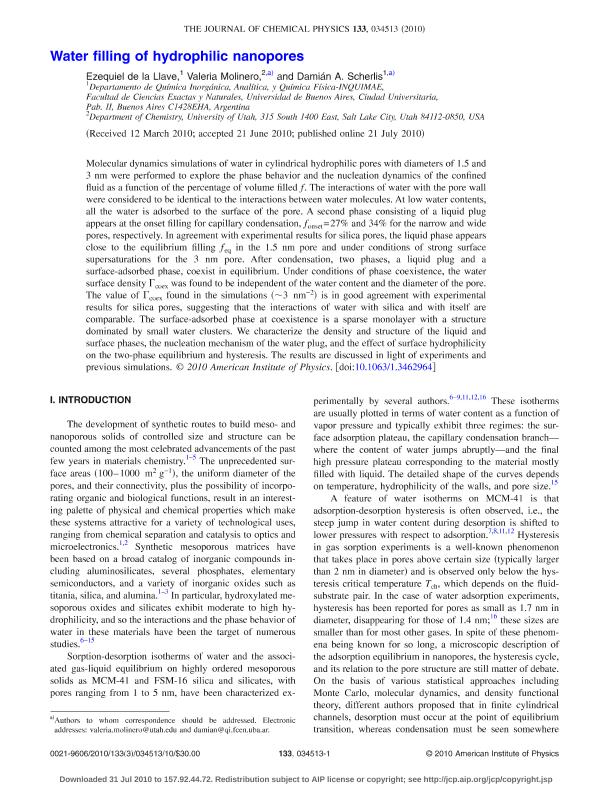Mostrar el registro sencillo del ítem
dc.contributor.author
de la Llave, Ezequiel Pablo

dc.contributor.author
Molinero, Valeria
dc.contributor.author
Scherlis Perel, Damian Ariel

dc.date.available
2019-03-19T16:17:08Z
dc.date.issued
2010-07
dc.identifier.citation
de la Llave, Ezequiel Pablo; Molinero, Valeria; Scherlis Perel, Damian Ariel; Water filling of hydrophilic nanopores; American Institute of Physics; Journal of Chemical Physics; 133; 3; 7-2010; 34513-34523
dc.identifier.issn
0021-9606
dc.identifier.uri
http://hdl.handle.net/11336/72008
dc.description.abstract
Molecular dynamics simulations of water in cylindrical hydrophilic pores with diameters of 1.5 and 3 nm were performed to explore the phase behavior and the nucleation dynamics of the confined fluid as a function of the percentage of volume filled f. The interactions of water with the pore wall were considered to be identical to the interactions between water molecules. At low water contents, all the water is adsorbed to the surface of the pore. A second phase consisting of a liquid plug appears at the onset filling for capillary condensation, fonset =27% and 34% for the narrow and wide pores, respectively. In agreement with experimental results for silica pores, the liquid phase appears close to the equilibrium filling feq in the 1.5 nm pore and under conditions of strong surface supersaturations for the 3 nm pore. After condensation, two phases, a liquid plug and a surface-adsorbed phase, coexist in equilibrium. Under conditions of phase coexistence, the water surface density Tcoex was found to be independent of the water content and the diameter of the pore. The value of Tcoex found in the simulations (∼3 nm-2) is in good agreement with experimental results for silica pores, suggesting that the interactions of water with silica and with itself are comparable. The surface-adsorbed phase at coexistence is a sparse monolayer with a structure dominated by small water clusters. We characterize the density and structure of the liquid and surface phases, the nucleation mechanism of the water plug, and the effect of surface hydrophilicity on the two-phase equilibrium and hysteresis. The results are discussed in light of experiments and previous simulations. © 2010 American Institute of Physics.
dc.format
application/pdf
dc.language.iso
eng
dc.publisher
American Institute of Physics

dc.rights
info:eu-repo/semantics/openAccess
dc.rights.uri
https://creativecommons.org/licenses/by-nc-sa/2.5/ar/
dc.subject
Water
dc.subject
Nanopore
dc.subject.classification
Otras Ciencias Químicas

dc.subject.classification
Ciencias Químicas

dc.subject.classification
CIENCIAS NATURALES Y EXACTAS

dc.title
Water filling of hydrophilic nanopores
dc.type
info:eu-repo/semantics/article
dc.type
info:ar-repo/semantics/artículo
dc.type
info:eu-repo/semantics/publishedVersion
dc.date.updated
2019-03-08T20:27:58Z
dc.journal.volume
133
dc.journal.number
3
dc.journal.pagination
34513-34523
dc.journal.pais
Estados Unidos

dc.journal.ciudad
Nueva York
dc.description.fil
Fil: de la Llave, Ezequiel Pablo. Consejo Nacional de Investigaciones Científicas y Técnicas. Oficina de Coordinación Administrativa Ciudad Universitaria. Instituto de Química, Física de los Materiales, Medioambiente y Energía. Universidad de Buenos Aires. Facultad de Ciencias Exactas y Naturales. Instituto de Química, Física de los Materiales, Medioambiente y Energía; Argentina. Universidad de Buenos Aires. Facultad de Ciencias Exactas y Naturales. Departamento de Química Inorgánica, Analítica y Química Física; Argentina
dc.description.fil
Fil: Molinero, Valeria. University of Utah; Estados Unidos
dc.description.fil
Fil: Scherlis Perel, Damian Ariel. Consejo Nacional de Investigaciones Científicas y Técnicas. Oficina de Coordinación Administrativa Ciudad Universitaria. Instituto de Química, Física de los Materiales, Medioambiente y Energía. Universidad de Buenos Aires. Facultad de Ciencias Exactas y Naturales. Instituto de Química, Física de los Materiales, Medioambiente y Energía; Argentina. Universidad de Buenos Aires. Facultad de Ciencias Exactas y Naturales. Departamento de Química Inorgánica, Analítica y Química Física; Argentina
dc.journal.title
Journal of Chemical Physics

dc.relation.alternativeid
info:eu-repo/semantics/altIdentifier/doi/https://doi.org/10.1063/1.3462964
dc.relation.alternativeid
info:eu-repo/semantics/altIdentifier/url/https://aip.scitation.org/doi/full/10.1063/1.3462964
Archivos asociados
